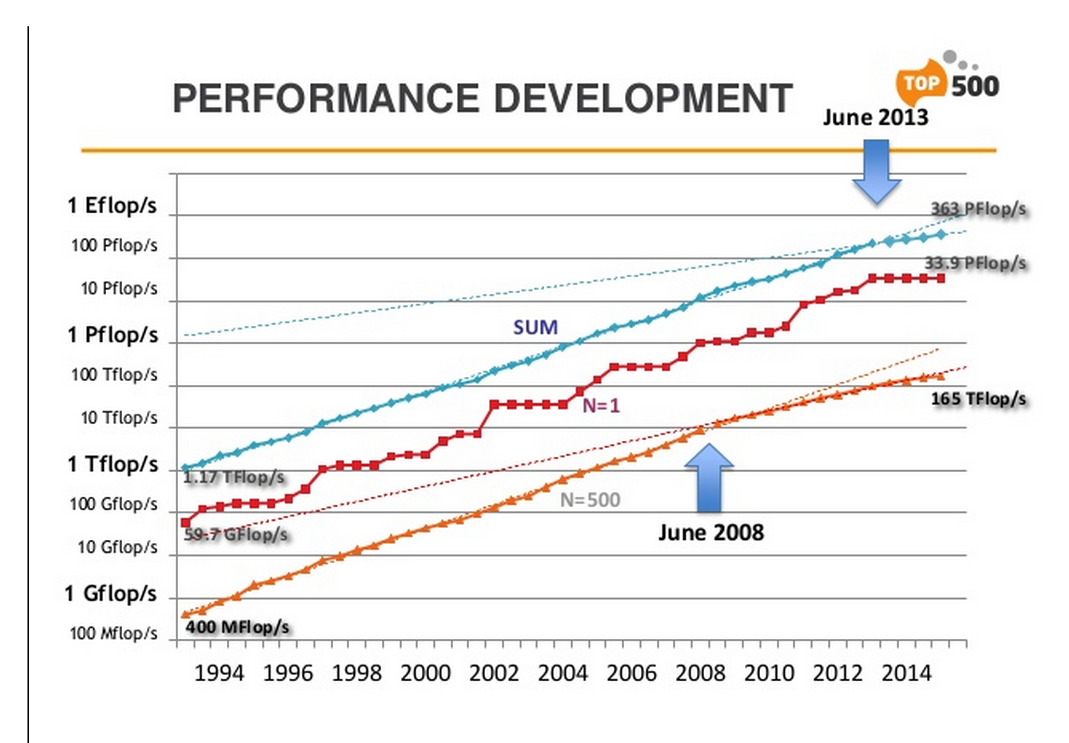When China grabbed the TOP500 crown for its Tianhe-2 supercomputer in June 2013 with double the peak FLOPS of the next fastest machine (Titan at Oak Ridge National Laboratory), could anyone have foreseen that the machine would still hold on to the top spot a full two years later? As we can see from the 45th edition of the twice-yearly TOP500 list, which was published Monday in tandem with the 2015 International Supercomputing Conference, not only did Tianhe-2, or “Milky Way-2,” retain its position, the top five systems remain unchanged:
And in these last two years, spanning five iterations of the list, there are only two new machines in the top 10: Piz Daint, the Cray XC30 at the Swiss National Supercomputing Centre (CSCS), Switzerland, with 6.27 LINPACK petaflops and Shaheen II, the Cray XC40 installed at King Abdullah University of Science and Technology in Saudi Arabia, with 5.53 LINPACK petaflops coming in at the six and seventh spots respectively, pushing down SuperMUC (IBM/Lenovo, Leibniz Rechenzentrum, Germany, 2.89 petaflops) and Tianhe-1A (National Supercomputing Center in Tianjin, China, 2.56 petaflops).
That was the two-year view. Comparing the June 2015 with the previous list from November, there is only one new addition in the rarefied top 10 zone: Saudi Arabia’s Shaheen II, which pushed out the 3.57 petaflops Cray CS-Storm system installed at an undisclosed US government site.
The degree of stagnation at the top of supercomputing is unprecedented and speaks to the challenges that the upper echelon of high-performance computing is facing, most notably attributed to the limitations of Moore’s law by luminaries such as Berkeley Lab Deputy Director and TOP500 author Horst Simon and many others.
Illustrative of the severity of this slowdown, the TOP500 organizers confirm that the last two years have seen historically low year-over-year performance increases in the overall list, and that’s with the bolstering effect of the very large systems that sit on the top of the list. The current list reflects a combined performance of 363 petaflops for all 500 systems, compared to 309 petaflops six months ago and 274 petaflops one year ago.

Further, the performance of the last system on the list (#500) has lagged behind historical trends for the last six years with a marked shift in its performance trajectory. Since 2008, performance of that #500 system is rising 55 percent per year. Contrast that to the annual growth rate of 90 percent seen between 1994 to 2008 in the period of performance scaling that is coming to be recognized as the heyday of Moore’s law.
While the continued standstill is fairly dramatic, it didn’t come as a surprise. Most obviously, given multi-year procurement cycles, the slowdown we are seeing today is a holdover from recession-era investment levels. Perhaps just as significant, however, the major sites that buy these leadership-class systems have been in a holding pattern as they waited to see what technologies and architectures would provide the biggest value for their users and workloads.
In the past, with a strong Moore’s law driving faster, cheaper, more energy-efficient sequential processing advances, typical refresh cycles would center on next-generation CPUs, but with the move to more and more heterogeneity, there are multiple technology cycles to watch, this includes Tesla GPU SKUs from NVIDIA, the Intel MIC line, and the continued evolution of 64-bit ARM. There are also new memory and storage technologies (NVRAM, burst buffers, SSDs, memristors) and next-gen interconnects (NVIDIA’s NVLink, Intel Omni-Path, etc.).
Many of these promised advances are about to come to fruition and the pipelined systems that hinge on them will revive list motility; this should start to happen in the six months to a year. In the US, the ACES and CORAL collaboration efforts are on track to produce five major systems ranging from 30 to 180 petaflops. The Trinity supercomputer is contracted to provide the National Nuclear Security Administration (NNSA) with 40 petaflops of compute power. Installation of the $174 million Cray XC40 machine is scheduled for this summer, but it is unknown if there will be enough lead time to have it up and benchmarked by SC15 and the next iteration of the TOP500 list.
The system will be physically located in Los Alamos at the Nicholas Metropolis Center for Modeling and Simulation and will be managed and operated by Los Alamos National Laboratory and Sandia National Laboratories under the Alliance for Computing at Extreme Scale (ACES) partnership.
Other US systems are expected along the following timeline:
2016: Cori, NERSC (> 30 petaflops)
2017: Summit, ORNL, OLCF (150 petaflops)
2018: Sierra, LLNL, NNSA (150 petaflops)
2018: Aurora, ANL, ALCF (180 petaflops)
Japan and Europe are also ramping up their “exascale-focused” agendas, although most nations have given up the aim of hitting the 2020 timeframe. As Horst Simon has observed, if exascale were going to make the 2020 deadline in the US, the CORAL systems (Summit, Sierra and Aurora) would have had to be installed already, yet they are still two to three years off.
Given China’s long-running FLOPS lead, it was a top contender in the race to break the next 1,000X performance barrier. Tianhe-2 was due to receive an infusion of tens of thousands of Intel Xeon chips that would have expanded it past the 110 petaflops mark until bans put in place by the US government derailed those upgrade plans.
Last August, Intel was asked by the US government to apply for an export license authorizing the shipment to Chinese system maker Inspur, but the application was denied, blocking the chipmaker from assisting with Tianhe-2’s upgrade path. Shortly thereafter, four Chinese supercomputer centers were blacklisted by the US government on the grounds that they were “acting contrary to the national security or foreign policy interests of the United States.”
Many in the industry see this as political posturing and fear the move may backfire, spurring China to accelerate its homegrown chipmaking program. While a completely indigenous machine has long been a goal for the protectionist nation, ready access to US microprocessor technology in combination with the supreme difficulty of chip innovation had a dampening effect. With this critical componentry supply effectively shuttered, China will be forced to redouble its efforts to engineer a completely indigenous supercomputing stack.
In a sign of just how serious China is about building its domestic semiconductor business, albeit on the memory side, the Chinese state-owned chip designer Tsinghua Unigroup Ltd. just made a $23 billion bid for US memory manufacturer, Micron Technology. Analysts say the deal, which would be the largest transfer of its kind, would face intense scrutiny by US officials concerned with the security and anti-trust implications of allowing the last memory chipmaker in the US to be transferred to a state-controlled entity.






























































